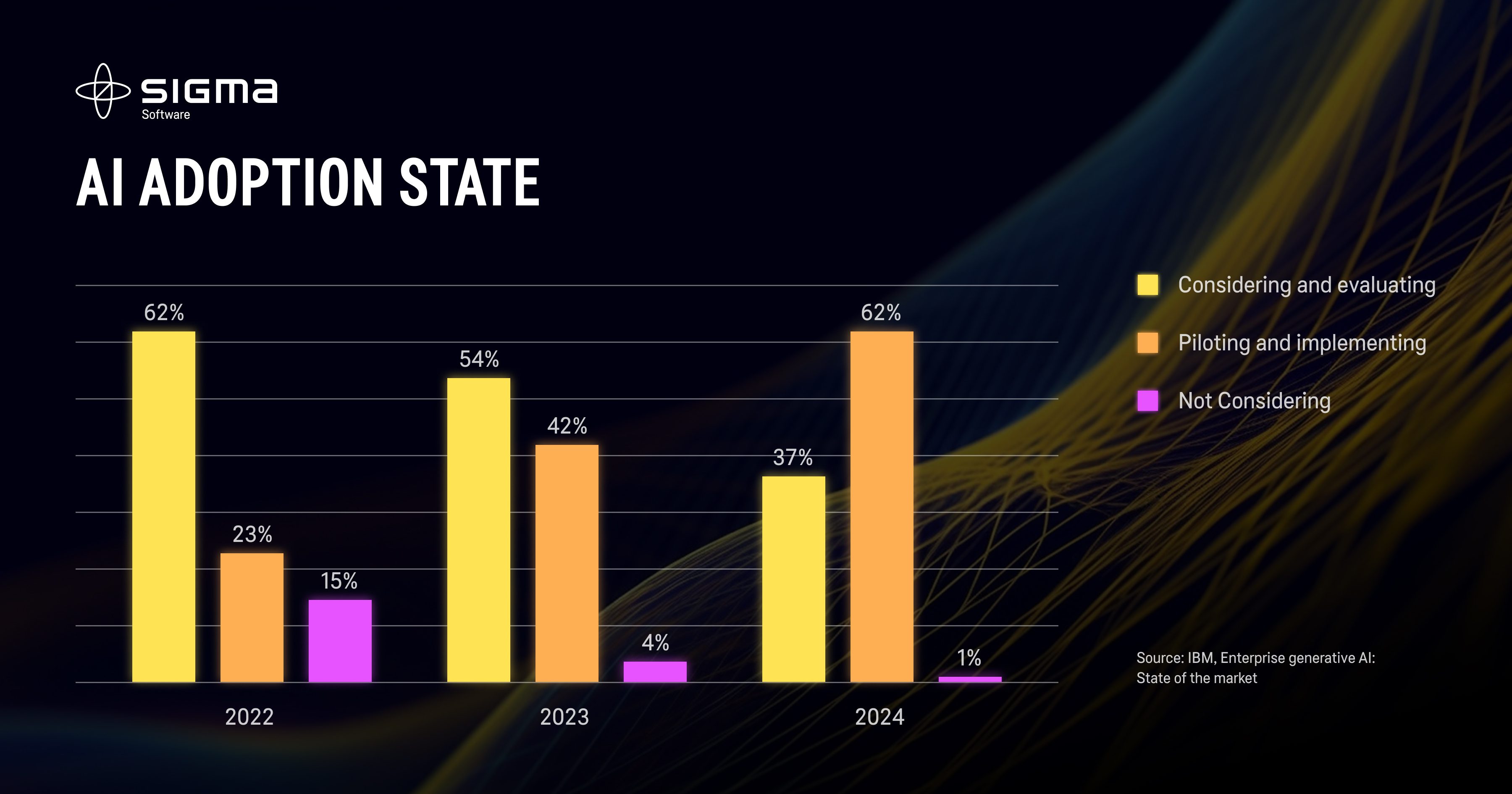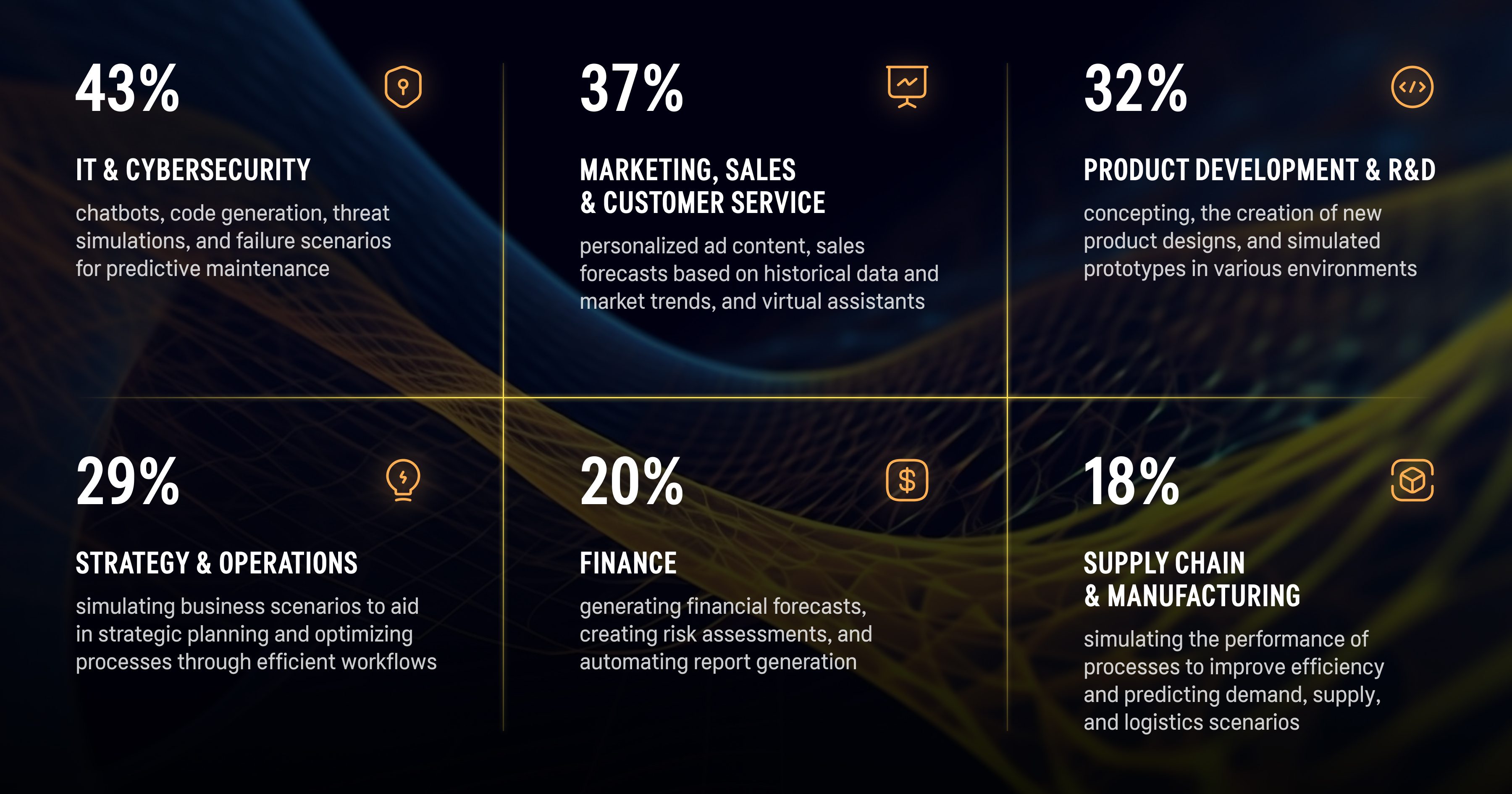AI Adoption: Think HOW not IF or WHEN
Investigate: Finding Your Champions
Thank you for reaching out to Sigma Software!
Please fill the form below. Our team will contact you shortly.
Sigma Software has offices in multiple locations in Europe, Northern America, Asia, and Latin America.

USA

Sweden

Germany

Canada

Israel

Singapore

UAE

Australia

Austria

Ukraine

Poland

Argentina

Brazil

Bulgaria

Colombia

Czech Republic

Hungary

Mexico

Portugal

Romania

Uzbekistan
In 2023, the popularity of AI skyrocketed, making the technology even more accessible and drawing higher investments. This, in turn, accelerated its advancement and industry-wide adoption, with more than 70% of companies expected to use AI-based architecture by 2026. It’s safe to say that AI is not a passing trend but an integral part of new business reality. Therefore, understanding the common challenges and planning an effective strategy for AI adoption is essential to bring business value.
AI Adoption: Think HOW not IF or WHEN
Investigate: Finding Your Champions
Over the past year, AI has been the key topic in almost every strategic session with our current and potential customers. Even though AI technologies have been around for a while, the hype around it has been growing since the release of ChatGPT-3 in 2022.

In a nutshell, there are three major factors that have been driving AI advancements over the last two years:
A combination of these factors creates a solid foundation for wider adoption and prompts businesses to move from a wait-and-see approach to active implementation. The rising tendency to integrate AI has become quite evident in recent years. Back in 2022, only 23% of companies were actively experimenting with artificial intelligence, while in 2024 the number has reached 62% and is growing steadily.

“Looking at our customer base (We work with a lot of clients in diverse segments, not only AI-related) we see that most of the businesses at this point are either considering or have already started their AI adoption journey. It’s no longer a question of IF or WHEN, but rather HOW to do it fast and efficiently,” says Alexey Syrotiuk, VP of Innovations at Sigma Software.
GenAI and ML have already become a commodity for some businesses. So, there is no way we can ask ourselves IF we should use it in our organization. Now, it’s more about to what extent we want to push AI adoption in the next couple of years.
Thinking of it and working with our customers from diverse industries, we see three typical strategies that indicate the adoption stage a business is at. Those are: investigating, experimenting, and scaling.

Of course, a few businesses have already gone a long way and are at the later adoption stages. For those AI has already become a routine part of their business. We love contributing to such projects and building complex AI pipelines. Nevertheless, our main focus today is on supporting companies that struggle with the investigation, exploration, and scaling stages.
“The ultimate mission that we see, as a solution provider, is to get people to move from investigating to scaling, as we believe that with all the current capabilities this can be done rather fast and cost-efficiently,” says Alexey Syrotiuk, VP of Innovations at Sigma Software.
Successful AI adoption is all about the value it will bring. So, it is crucial to find the right business cases that will not only show that AI can be a part of your daily operations but will also result in tangible and measurable outcomes. Sounds like a piece of cake, but it is one of the key showstoppers that makes organizations linger on the investigation stage longer than they should or would like to.
Why does this happen? We see two major reasons – one is the lack of AI awareness. It is hard to grasp all the capabilities of the technology you have never used before. The other – is focusing too much on technology and losing sight of business. As a result, companies run technical pilots that add insignificant or intangible value, bringing to naught any sense to further invest in scaling.
Our advice is simple – there is no need to struggle with the challenge on your own. If you find it hard to define the right business cases you can always involve external experts to consult you on AI capabilities going beyond pure GenAI, run interviews with your team, and support you in shaping the business cases. It works best when such experts have not only AI competence but also business understanding. Their knowledge will help you navigate through all the variety of AI capabilities and focus on the most suitable ones.
Alternatively, it makes sense to have a closer look at successful implementation examples and try to map those to your organization’s business functions. For example, the recent report on GenAI adoption from Deloitte highlights that the following business functions within enterprises have the highest AI adoption rates.

Another piece of advice would be to choose a limited number of use cases aligned with a single topic or business vertical. This will help you keep the AI pilot’s efforts more focused.
If we only take the successful AI implementations we have done during the last 10 years, it sounds bright: legal assistants spotting legal risks in contracts, chatbots generating programming code, cloud-hosted generic AI assistants, and many other successful business cases that serve from tens to hundreds thousand of customers. Yet, these still are just below 10% of all the ideas we try. General statistics show that only 8-15% of AI PoCs progress beyond the initial phase.
Thus, finding a successful AI case is as hard as building a new product with good market fit, and doing it right. Thus, fail fast and fail forward is a natural way to go. The key at this stage is to be ready so that only a few of the PoCs will be successful and focus on reducing the pilots’ costs.
At Sigma Software we cope with this challenge by limiting the scope as much as possible, using cheaper data to validate the idea, and relying on a set of partner products that allow us to reduce PoC cost. Namely, we use Datuum.ai to scout data across organizations, run AI-enabled automated data labeling, and generate scripts to enable the use of this data for building data pipelines for the PoC. And we use Datrics.ai to build PoCs on top of the generated data sets. Thus, we manage to run our PoCs much faster than it would take with commodity toolsets.
So, you have chosen the right business cases and ran a successful pilot that demonstrated expected business value. Your team is inspired and burning to scale the success by moving the pilot to production. Seems like nothing can stop this from happening, but… The investments needed for scaling the pilot are often far higher than running the pilot itself. So, even with a pilot being successful, companies end up freezing the initiative because they don’t have the necessary budget or are not ready to invest at scale.
One may say you should have put a bit more effort into the investigation and pilot stages to make sure the business case you designed would not take an arm and a leg to scale. Fair enough. We often recommend clients to start experimentation with something smaller, more of a low-risk, medium-gain kind. But what if you found a perfect business case that is transformative, promises substantial business value, and the only thing that stands between you and the bright future is the lack of budget?
Our suggestion for such cases is to look for external financing.
First of all, hyperscalers, such as Microsoft, Google, and Amazon have co-financing initiatives for projects that will further utilize their cloud services. So, if you plan to use one of the hyperscalers’ clouds, it makes sense to apply for their financing programs. Another way is to opt in for programs from numerous government and corporate funds that actively invest in AI projects.
However, even though funding is often the major showstopper at this stage, it is not the only thing you need to take care of. At this point, it is also important to turn early-stage AI initiatives into a solid approach with a clear strategy, processes, quality, and security governance practices. This may seem challenging, but as a rule, by the time you achieve this phase, you will have already done a lot of groundwork. Thus, it is more a matter of structuring things and incorporating them into your processes and vision. If you find it challenging to do this in-house, you can involve external consultants to support you with AI security, compliance consulting, or fine-tuning your AI development processes and workflows.
Over the past few years, we not only supported the clients in their AI adoption journey but also charted our own path, actively experimenting with AI. This experience bolstered our knowledge base, so we’ll be happy to share the expertise and insights we gained. If you have any questions or need help, our experts are ready to help you with:
Feel free to contact our team for expert guidance and assistance in moving your AI project to the next stage

Sigma Software Group provides IT services to enterprises, software product houses, and startups. Working since 2002, we have build deep domain knowledge in AdTech, automotive, aviation, gaming industry, telecom, e-learning, FinTech, PropTech. We constantly work to enrich our expertise with machine learning, cybersecurity, AR/VR, IoT, and other technologies. Here we share insights into tech news, software engineering tips, business methods, and company life.
Linkedin profileAI Adoption: Think HOW not IF or WHEN
Investigate: Finding Your Champions


On November 27, in Lviv, Forbes AI Summit brought together entrepreneurs, technology leaders, and scientists for an honest conversation about how AI is reshapin...

The EU Data Act went live in September 2025. Its rollout across Europe has been uneven, with only a few member states having completed the national set-ups. Nev...

For years, manufacturers have been talking about the advantages of shifting to outcome-based business models. The rise of AI has made the opportunity for transf...
Would you like to view the site in German?
Switch to German